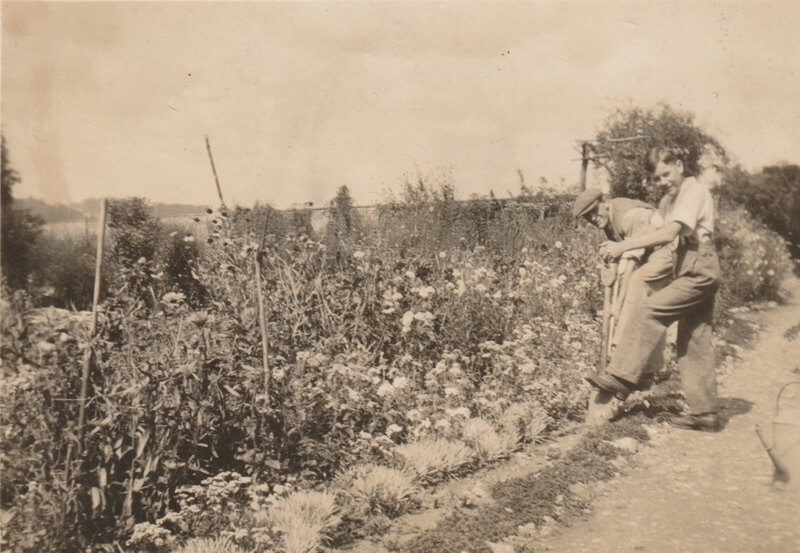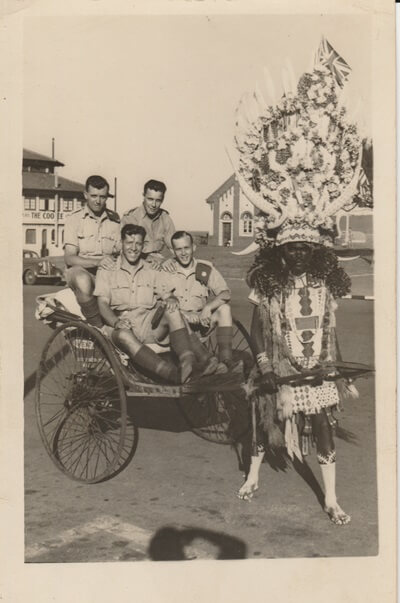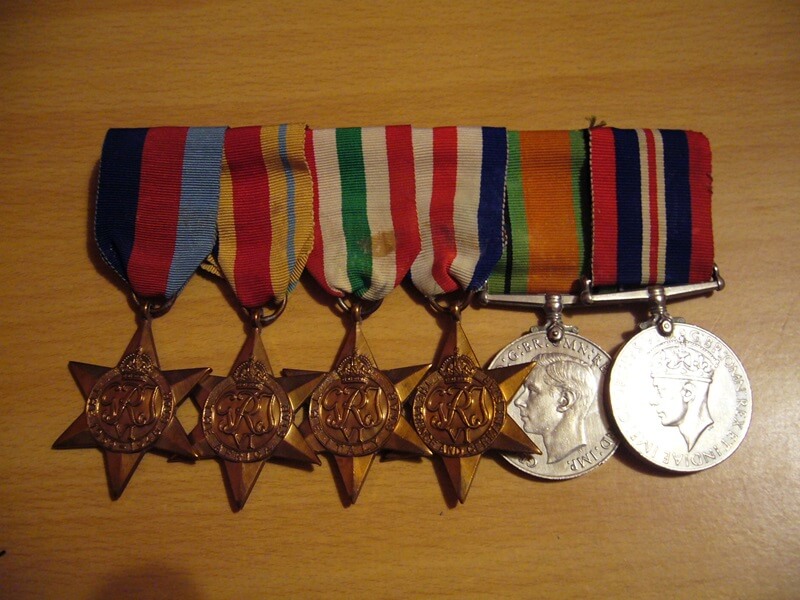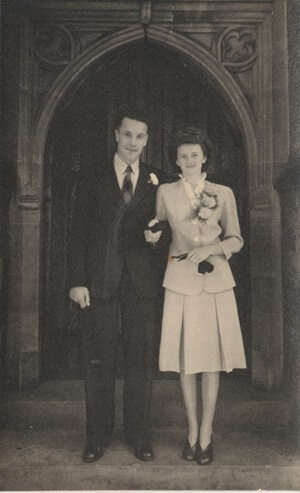
This article is based on From Brill to Basra, the story of a Buckinghamshire lad who travelled the world! by Trevor Rolfe.
Prepared for the museum by Alison Bailey
As a driver in the Royal Army Service Corp, Jim Rolfe had an extraordinary war. His job was to support the 5th Infantry Division, who became the most travelled British Army unit in WWII and were known as the ‘Globetrotters’. This young lad from rural Buckinghamshire drove through India and the deserts of Iraq, and from the beaches of Sicily to the death camp at Belsen. After this experience, Jim was more than content to stay at home in Amersham for the rest of his life!
A Buckinghamshire Lad
James Victor Rolfe was born in the West Buckinghamshire village of Brill (30 miles northwest of Amersham). The 7th of eleven children, five girls and six boys, born to James Henry and Lily (née Shipperly) Rolfe. In his memoirs and diaries, Jim described a tough rural childhood as his father struggled for money when he couldn’t work because of severe rheumatoid arthritis. Jim and his siblings had their chores. Jim had to dig up potatoes on the family allotment, chop wood, clean out neighbours’ chicken houses, and fetch heavy pails of water from the well on wash day. His mother took in washing and his father swept chimneys when he could.
Amersham
Jim gained a scholarship to Aylesbury Grammar but there was not enough money for the uniform or bus fares. Instead, Jim left school at the age of 14 and went to live with his brother Tom and his wife Gladys in Amersham, with the hope of getting work. He was accepted as an odd job boy at St Mary’s Rectory and shortly afterwards moved to lodge with Miss Line at 35 Whielden Street.

“My tasks at the Rectory consisted of cleaning shoes, plucking pheasants and getting in coal and wood for the cook. When this was done, I worked in the gardens under Stan Mills, who was well known in the area for his produce at shows at different towns and villages around the area. I was very happy here. I left at the age of 16 and worked at the Misbourne hand laundry, earning eighteen shillings a week. I was never happy in this job and was not sad when my call-up papers arrived”.

The Royal Army Service Corps
Jim enlisted in the army in March 1939 and when war was declared in September, he was called up, just after his 21st Birthday. Before leaving, Jim carved his name into the barn beams in Bury farm, owned by his friend, the farmer, Don Jarvis. In 1994, the barn was converted into a house and Don recovered the piece of wood and gave it to Jim. The family still has it today.
Jim was enlisted in the Royal Army Service Corps (RASC) whose role was to keep the front-line units supplied with provisions, petrol and ammunition. Jim completed seven weeks intensive training with the driver training school on Salisbury Plains, before he was sent to France in November 1939.
“Once in France I went onto Le Mans for a few weeks, where I was supplied with a three-ton Bedford tipper lorry which was commandeered by the army to supply the front-line troops from the main supply depots. All our vehicles were a motley lot, Morris’s, Chevrolets, Fords and even one Armstrong Siddeley!”
Dunkirk
Jim’s unit retreated towards Dunkirk. He had to drive his lorry into a field of about 20 acres which was very tightly packed with hundreds of other vehicles and then the Royal Engineers set light to them to make sure they couldn’t be used by the Germans.
“We then marched for about four days to Dunkirk after calling at a café, which appeared to be abandoned, and getting a bottle of rum. No problem on the beach with this little tipple as my mate (Ron Legg from Blanford) and I buried ourselves well down in the sand, I with the Bren gun and piles of 303 ammunition and he with a 55-inch anti-tank gun. We were heavily shelled, bombed and strafed by Messerschmitts and we made up for lost opportunities, firing on Stuka dive bombers. We were on the beach for four days and three nights and in between times we were called upon to take ambulances back to pick up and dispatch wounded soldiers and civilians, until the jetty was eventually destroyed by the shelling of German heavy artillery. We then had our orders to take to the little boats”.
Jim eventually got into an overloaded trawler:
“It was inspiring to see these little motorboats, towing two or three little rowing boats backwards and forwards from the shore out to the fishing boats and trawlers etc. for those people who were unable to swim. One man driving a motorboat was very sick and we pulled his leg, but he said he hadn’t been on the sea before (he was a clerk in an office in London) but had volunteered to help; he was a very brave man”.
On the morning of 2 June, Jim reached Ramsgate where he was greeted with soup and sandwiches. Jim sent a specially printed postcard to his mother to say that he had arrived safely in England.
Leave
Jim went home for five days’ leave but when he arrived home and walked through the door his mother collapsed as she was very shocked to see him. She hadn’t received the postcard from Ramsgate and naturally thought that he hadn’t escaped from Dunkirk. Each time she went up to the village, people were saying their boys were home and Mrs Rolfe naturally thought Jim was a prisoner or worse, dead.
The Globetrotters
In February 1942, after training in Northern Ireland, Jim’s unit was sent to Africa, to support the 5th with the planned invasion of Madagascar. Here they were greeted by a soprano, known as ‘The Lady in White’, on the quayside. Her real name was Perla Siedle Gibson, and she sang rousing English songs through a megaphone as each ship arrived and departed.
The night before Jim had won £28 at Bingo, which was played twice a week on the mess deck. This was a small fortune considering his pay was £1 – 1 shilling a week.

“Myself, Ron Legge, Len Daniels and Bob Cook really hit it up in Durban for the two and a half weeks we were there! I met two sailors from Amersham one night at the roller-skating rink, Len Sawyer and Chic Larki – they were serving on the battleship Valiant which had been damaged and was in Durban for repairs. Two of us were invited for an evening meal on board, which was super”.
A month later they were on the move to India and travelled from Bombay to Burma (now Mumbai and Myanmar) in a convoy of 3-ton Dodge lorries. Jim described the stark contrast of the squalor of Grant Road, Bombay where dozens of lepers were lying in the streets, to the beauty of the Taj Mahal and the elegant tree lined avenues of Allahabad.
In Ranchi, Jim took tiffin (the midday meal) with a retired Civil Engineer. A Mr. Davidson from Amersham had told him to enquire about him if he ever found himself in that area. He also saw Gandhi in Bombay, just before his arrest and subsequent imprisonment.
Just three months after arriving in India the division was on the move again to the Middle East. Here Jim experienced the terrific dry heat of a “godforsaken” Basra before he had to climb the Zagros Mountain range to the bitter cold of Kermanshah, Iran. Jim caught an iguana up in the mountains, about two feet long and kept it during the stay, feeding it on scraps. His unit also bought and kept 20 young turkeys to fatten for Christmas. However, in mid-November 1942, Jim received a letter from his landlady Miss Line containing the terrible news that his mother had died. Christmas was spent in Qom about 30 miles south of Tehran where the turkeys were eaten. After spending time in Palestine and Egypt, Jim’s unit eventually returned to Europe in July 1943.
Italy

In heavy seas and strong winds, the division landed at dawn at Avola, Sicily before crossing to mainland Italy in September. Jim’s unit lost two men when anti-personnel mines were dropped by parachute and exploded about 10 feet above their landing craft. Now promoted to Lance Corporal, Jim spent several months in the Naples area ferrying supplies at night on American landing craft under constant bombardment by fighter bombers and a large rail mounted gun, nicknamed ‘Anzio Annie’. He went to the opera house and Pompei: “Vesuvius was throwing out a very fine molten dust and our lorries were covered with it – it came down like rain and people walked about with umbrellas”. He visited the Colosseum in Rome and the Vatican City where he even had an audience with the Pope!
The End of the War
In March 1945, driving day and night (with new night vision binoculars) the division crossed Belgium and into Germany. Lack of sleep led to a near accident when Jim ran off the autobahn one night straight through a large sign saying, ‘Beware deer on road’. Luckily the ploughed field was level with the road, so he stuck the old Bedford truck in four-wheel drive and pulled out. None of the men in the back of the lorry knew that he had fallen asleep and gone into a field, as they were too exhausted themselves.
In Germany Jim witnessed the devastation of the bombing raids where Hamburg was “literally burnt to a shell”. Worst horror was to follow when the unit was sent to Belsen concentration camp to move interns to nearby homes and camps: “It was the most pathetic sight imaginable; a number of drivers couldn’t carry on and had to be replaced. You have no doubt read reports of the concentration camps and I have no need to repeat anything here”.


Civilian Life
Jim returned to Amersham in January 1946. He had served for six years and was hospitalized three times, with German measles in Dieppe, with Malaria in Bombay and with hepatitis in Tehran. Ironically, he only received an injury at the end of the war when a careless guard accidentally shot him in the thumb. To add insult to injury, Jim was demoted back to the rank of Driver for “failing to maintain alertness”.
Sadly, Jim lost both his parents during the war as his father also died just weeks before he was demobbed on 28 January 1946. Jim returned to lodge with Miss Line and got a job working as a stores man at the bus garage. At a dance in the Conservative Rooms he met an Irish nurse, Mary Coghlan (Mollie). The couple were married on 4 October 1947 at Our Lady’s Catholic Church in Chesham Bois with Don Jarvis acting as Jim’s best man and Eileen Lynch as Mollie’s bridesmaid.

After the war, housing was in very short supply in Amersham because of the influx of evacuees and refugees to the town. The couple rented in Lexham Gardens until Jim bought an old Dakota airplane that had been converted into a caravan, from Bovingdon Airfield, which had been an American base during the war. The Dakota was an American C-47 transport plane and had worn the distinctive black and white recognition stripes on the wings and fuselage (known as D-Day stripes) before conversion to the caravan. Jim believed that that the Dakota had been used as a paratrooper and glider towing plane during ‘Operation Overlord’ in the invasion of Europe on D-Day. The purchase price did not include delivery but eventually, with some help, Jim managed to move it, and Don Jarvis kindly gave him a place to put it next to the old orchard on Bury Farm.
“It made a fine static caravan home (although rather chilly in winter) and we lived there until the autumn of 1952. Our first child Alan was born in December 1948 and our daughter Elaine in February 1952. When Elaine was eight months old, we finally reached the top of the council housing list and moved to our new 2-bedroom end of terrace council house at 38 Briery Way, Amersham, which had a large garden”.
Jim went on to work for Amersham Rural District Council as a building maintenance supervisor and in September 1964, a third child, Trevor, was born.
A life well lived
Amongst Jim’s many interests were gardening and cricket. His garden and greenhouse provided a constant flow of vegetables for the family all year round and he played cricket for Coleshill Cricket Club well into his fifties. Most Sundays he would take his children down to visit Don and Mary Jarvis at Bury farm and holidays were spent visiting Mollie’s brother and family at the family farm in Ireland.

Jim Rolfe died at the age of 80 on 16 October 1998 and is buried at The Platt Cemetery. He left behind his wife Mollie, sons Alan and Trevor, and daughter Elaine. Sadly, he didn’t get to meet his 7th grandchild who was born the following year. According to the family this grandson “was always going to be a James….and just sometimes parts of James Rolfe senior are seen in James Rolfe junior”!
Sources
From Brill to Basra, the story of a Buckinghamshire lad who travelled the world! by Trevor Rolfe
Trevor Rolfe
Elaine Eyres
Ancestry.com

